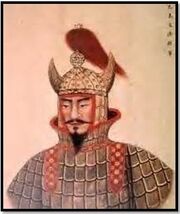
General Kim Duk Ryang
Choong-Jang is one of the 2nd degree black belt forms used in ITF-style taekwondo. Choong Jang is said to be the pseudonym given to General Kim Duk Ryang who lived during the Yi Dynasty (14th Century). This pattern ends with a left-hand attack, intending to symbolize the tragedy of his death at age 27 in prison.
Reading multiple authors, it is not entirely clear who the historical figure Kim Duk Ryang was. An oft-quoted source is Turtle Taekwondo:
- Kim Duk Ryang (possibly also Chung Ki Ryong or Kim Duk Nyung) was born in 1567; he was a commander in the army during the Yi Dynasty. In 1592 when Toyotomi Hideyoshi began the Japanese invasion of Korea known as the Imjin Wars, Kim Duk Ryang was promoted to General. The invading Japanese were armed with around 300,000 imported muskets and faced Korean forces mostly armed with swords, bows, arrows and spears in guerrilla groups. On land the Korean forces struggled, while at sea the naval forces of Admiral Yi Sun-Sin were victorious.
- In 1594 Kim Duk Ryang was promoted to Commander in Chief of the Honam Province, under his great leadership and with a fellow commander Ja Wu Kwak the army was able to repel the Japanese forces from the province.
- The Japanese greatly feared Kim Duk Ryang and gave him the name General Ho-Ik meaning Tiger Wing. The bitter rivalries at court also had their impact on Kim Duk Ryang, when he was arrested in 1595 in connection with the killing of a slave girl.
- His success on the battlefield may have led to the King’s intervention and his release by royal decree. He was finally killed in 1596, by poisoning; after allegations that he took part in the Mong Hak Lee (Yi) rebellion, he was posthumously cleared of all charges and dishonor.
Video[]
Why was this video chosen for use on this wiki? Do you have a better video? Please see Video Guidelines before replacing this video with a better one.
Diagram[]
No diagram has yet been added for this technique. You can contribute to Taekwondo Wiki by adding an appropriately licensed diagram.
Written Instructions[]

The lines of Choong-Jang (student view)
Here on this wiki, the wording used to describe this form deviates from the conventional wording historically used to describe the form. This was done to facilitate wiki-style links to the names of associated techniques. To view the conventional wording, see ITF Forms Summary Description.
- Ready Posture: Closed Ready Stance Type A
- 1. Step the right foot toward A to form a Sitting Stance facing D. Right Inner Forearm Side Front Block; extend the left forearm downward to the side.
- 2. Execute a Left Inner Forearm Side Front Block; extend the right forearm downward to the side, while maintaining a Sitting Stance facing D.
- 3. Bring the right foot to the left foot forming a Closed Stance facing D, while executing a Left Angle Punch. Perform slowly.
- 4. Step the left foot toward D to form a Left Walking Stance facing D. Right High Two-Finger Thrust to D.
- 5. Step the right foot toward D to form a Right Walking Stance facing. Left High Two-Finger Thrust to D.
- 6. Execute a Right Backfist Strike to D, while maintaining a Right Walking Stance facing D.
- 7. Step the left foot toward D into a Left Walking Stance facing D. Left Rising Block.
- 8. Step the right foot toward D to form a Right Walking Stance facing D. Right Middle Punch to D.
- 9. Step the right foot toward C turning counterclockwise, then slide to C to form a Right L-Stance (i.e., left foot forward) facing D. Middle Guarding Block to D.
- 10. Execute a low Right Front Snap Kick to D keeping the position of the hands as they were in 9.
- 11. Lower the right foot to D into a Right Low Stance facing D. High Horizontal Fingertip Thrust to D.
- 12. On the ground, execute a Right High Turning Kick to D, supporting the body with both hands and the left knee.
- 13. Lower the right foot to D and then execute a Right High Punch to D, while pressing the ground with the left palm.
- 14. Step the left foot toward D turning clockwise to form a Left L-Stance (i.e., right foot forward) facing C. Left Elbow Thrust to D.
- 15. Step the left foot toward C turning clockwise to form a Left L-Stance (i.e., right foot forward) facing D. Middle Guarding Block to D.
- 16. Step the right foot toward C into a Right L-Stance (i.e., left foot forward) facing D. Scooping Block with the left palm.
- 17. Step the left foot toward C into a Left L-Stance (i.e., right foot forward) facing D. Right Middle Outward Knifehand Strike to D.
- 18. Execute a X-Fist Pressing Block, while pivoting with the right foot into a Left Walking Stance facing C.
- 19. Execute a Right Knee Strike to C, while pulling both hands as if grabbing the opponent's leg.
- 20. Lower the right foot to C into a Right L-Stance (i.e., left foot forward) facing D. Middle Knifehand Guarding Block to D.
- 21. Step the right foot toward D in a sliding motion to form a Right L-Stance (i.e., left foot forward) facing C. Right Elbow Thrust to D.
- 22. Execute a Middle Knifehand Guarding Block to D, pulling the right foot into a Left L-Stance (i.e., right foot forward) facing D.
- 23. Execute a Left Middle Side Piercing Kick to D, while, pulling both hands in toward the body.
- 24. Lower the right foot to D and then execute a Twin Palm Pressing Block while pivoting with the right foot into a Right Rear Foot Stance facing C.
- 25. Step the right foot toward C to form a Right Walking Stance facing C. Right High Outer Forearm Front Block to C and then a Right High Backfist Side Strike to C, maintaining a Right Walking Stance facing C.
- 26. Execute a High Vertical Fingertip Thrust to D, while pivoting with the right foot into a Right L-Stance (i.e., left foot forward) facing D.
- 27. Execute a Right Low Front Snap Kick to D, while bring the right palm on the left back hand.
- 28. Lower the right foot to D to form a Left Walking Stance facing C, pivoting with the left foot while bringing both fists to the right hip. Perform slowly.
- 29. Execute a Left Backhand Downward Strike, pivoting with the right foot into a Right L-Stance (i.e., left foot forward) facing C. Perform in a stomping motion.
- 30. Punch the left palm with the right fist, while maintaining a Right L-Stance (i.e., left foot forward) facing C.
- 31. Step the right foot toward C in a stomping motion to form a Left L-Stance (i.e., right foot forward) facing C. Right Backhand Downward Strike.
- 32. Punch the right palm with the left fist, while maintaining a Left L-Stance (i.e., right foot forward) facing C.
- 33. Execute a Left Middle Outward Knifehand Strike to D, while pivoting with the right foot into a Right L-Stance (i.e., left foot forward) facing D. Perform in a stomping motion.
- 34. Execute a Right High Side Backfist Strike to D, simultaneously striking the left palm with the right elbow, while sliding the left foot into a Left Walking Stance facing D.
- 35. Step the right foot toward D into a Left L-Stance (i.e., right foot forward) facing D. Right Middle Outward Knifehand Strike to D. Perform in a stomping motion.
- 36. Execute a High Side Backfist Strike to D, simulteneously striking the right palm with the left elbow, pivoting with the right foot into a Right Walking Stance facing D,.
- 37. Execute a Low Ridgehand Guarding Block to C, pulling the right foot into a Right L-Stance (i.e., left foot forward) facing C.
- 38. Execute a Right 9-Shaped Block, sliding the left foot into a Left Walking Stance facing C.
- 39. Step the right foot toward C into a Left L-Stance (i.e., right foot forward) facing C. Low Rigehand Guarding Block to C.
- 40. Execute a Left 9-Shaped Block, sliding the right foot into a Right Walking Stance facing C.
- 41. Step the right foot toward D into a Left Walking Stance facing C. Twin Knifehand Horizontal Strike.
- 42. Execute a Right High Arc-Hand Strike to C, while maintaining a Left Walking Stance facing C.
- 43. Execute a middle Right Front Snap Kick to C, keeping the position of the hands as they were in 42.
- 44. Lower the right foot to C into a Right Walking Stance facing C. Left High Arc-Hand Strike to C.
- 45. Execute a middle Left Front Snap Kick to C, keeping the position of the hands as they were in 44.
- Perform 46 and 47 in a fast motion:
- 46. Lower the left foot to C into a Left Walking Stance facing C. Right Middle Punch to C.
- 47. Execute a Left Middle Punch to C, while maintaining a Left Walking Stance facing C.
- 48. Bring the right foot to the left foot to form a Closed Stance facing C. High Crescent Punch with a twin fore-knuckle fist.
- 49. Step the left foot toward B turning counter-clockwise to form a Left Walking Stance facing B. Left Knifehand Low Block to B.
- 50. Execute a Right High Open Fist Punch to B, while maintaining a Left Walking Stance facing B.
- 51. Move the left foot on line AB into a Right Walking Stance facing A. Left Knifehand Low Block to A with the right Knifehand.
- 52. Execute a Left High Open Fist Punch to A, while maintaining a Right Walking Stance facing A.
- End: Bring the foot back to the ready position.
Black Belt Forms[]
The ITF-style Black Belt forms are:
- Kwang-Gae (39 movements) - 1st dan
- Po-Eun (36 movements) - 1st dan
- Ge-Baek (44 movements) - 1st dan
- Eui-Am (45 movements) - 2nd dan
- Choong-Jang (52 movements) - 2nd dan
- Juche (45 movements) - 2nd dan / Ko-Dang* (39 movements) - 2nd dan
- Sam-Il (33 movements) - 3rd dan
- Yoo-Sin (68 movements) - 3rd dan
- Choi-Yong (46 movements) - 3rd dan
- Yon-Gae (49 movements) - 4th dan
- Ul-Ji (42 movements) - 4th dan
- Moon-Moo (61 movements) - 4th dan
- So-San (72 movements) - 5th dan
- Se-Jong (24 movements) - 5th dan
- Tong-Il (56 movements) - 6th dan
Forms no longer used:
* Ko-Dang is an older form, replaced with Juche. Ko-Dang is still taught in some schools however.
U-Nam is an ITF/Chang Hon-style form that appears only in the 1959 edition of Choi Hong Hi's Tae Kwon Do Teaching Manual.
References[]
The primary reference is:
The following websites are also particularly good online references for ITF-style taekwondo:
